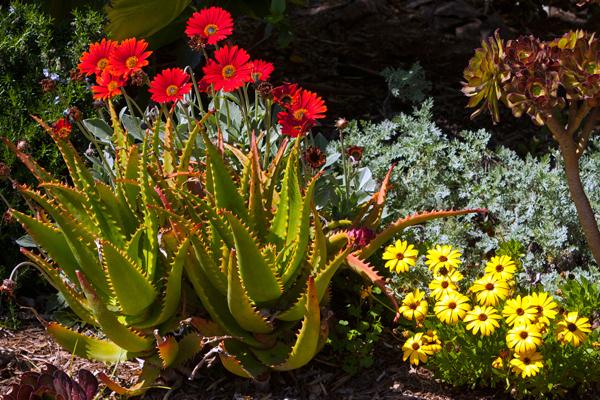With smart planning, building a beautiful California garden is easy. These six Smart from the Start tools will help you design a new garden or revamp an existing space.
What is Smart from the Start?
Smart from the Start is a water conservation program that provides California homeowners with the tools and templates they need to create a beautiful outdoor space that is appropriate for the California environment. Landscapes designed by the Smart from the Start program use less water, produce less yard waste and protect natural resources.
Try the following tools when designing your space:
- Water Smart Landscape Checklist. This checklist provides an overview of landscape and irrigation design considerations in a single place. It makes it easy to understand and meet water efficiency standards and clearly distinguishes the basics from higher-class upgrades so you can decide what’s best for you. The list is approved by the California Urban Water Conservation Council (CUWCC) and was developed in conjunction with landscape industry, government and business organizations, so you can feel confident in your decisions. The checklist also includes corresponding references to the California Model Water Efficient Landscape Ordinance if you want to know more.
- Front Yard Templates. Seven different front yard templates are available to choose the California climate that best describes your garden space. These templates map smart designs for typical yard dimensions and include detailed expert recommendations. In short, they’re the closest thing you can get to hiring an expert landscaper to do the work for you. The recommendations also provide room for flexibility, so you can use your creativity to distinguish your space from neighboring yards. These plans are truly outstanding and represent an incredible amount of effort invested by the state of California to promote water conservation.
- Back Yard Templates. Similar to front yard templates, backyard plans are available to suit a variety of specific California climates. However, backyard templates differ from their counterparts in that they reconsider the design of a private versus public space. These drawings include popular components like decks and seating considerations in addition to vegetable gardens, storage sheds, and compost bins. If you’ve ever been curious about installing one of these items but didn’t know how much room you’d need, it’s a good resource for you. Both yard templates make customization more accessible than before, helping you put knowledge behind every decision.
- Guide to Choosing Water-Wise Plants. Once you’ve chosen a layout using the tools noted above, this guide to selecting water-wise plants will help you pick out the best low-water-use plants suited for your environment. Smart plant choices require less maintenance and often need less fertilizer or pesticide, which is good for pets or children. The guide also includes recommendations for those wanting to revamp an existing space. Those interested can learn how to reduce their grass coverage and rethink their space. For additional help, San Jose Water maintains a searchable reference gallery of water-saving plants to help plan your lawn or garden space.
- Lawn and Plant Care. Learn how to care for your new garden space and keep your garden looking beautiful after installation with this online resource. Instructions include proper mowing, aeration, de-thatching, weeding, insect and disease control, and fertilizing practices. While lawn and plant care may seem like common sense, you’d be surprised at what you may not know. For example, some grasses brown naturally at the end of their growing cycles, regardless of water. Even experienced gardeners may learn something new by testing their knowledge against recommendations.
- Irrigation Plans. Avoid overwatering with this tool that takes you through the basics of watering and irrigation, including scheduling, maintenance, and new technologies. Because using too much water on the lawn is the most common cause of water waste, you’ll want to check current usage against the calculator that estimates water needs based on climate, time of year and lawn size. Any large discrepancy between the two would indicate inappropriate water use. Please check with your local water utility for any watering restrictions that may apply in your area. Also, take advantage of the handy links to other resources that can further advance your irrigation goals like free water audits that can help you understand your system better.

